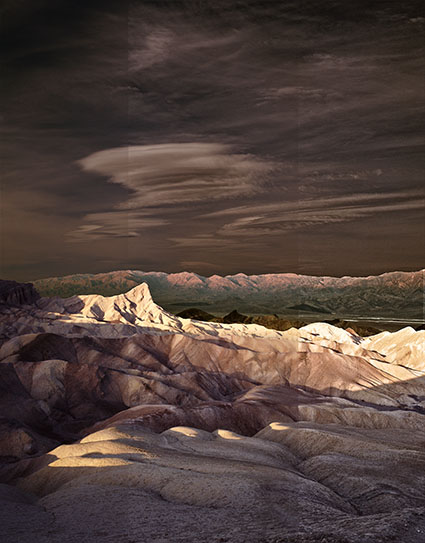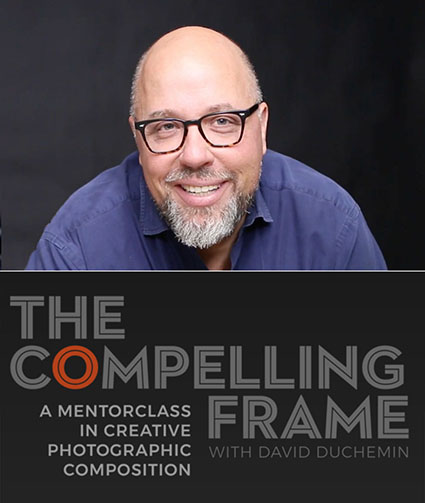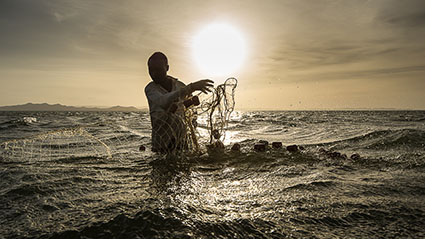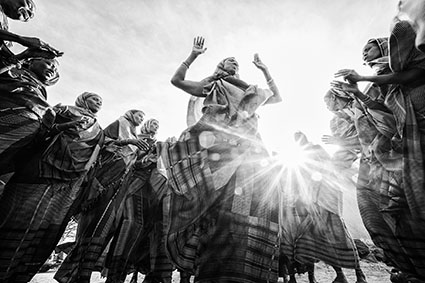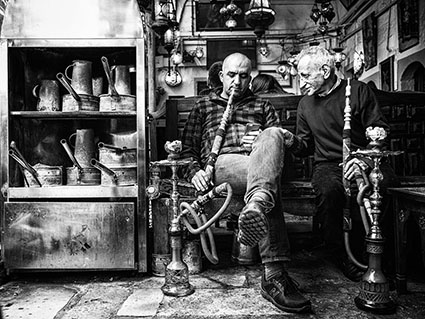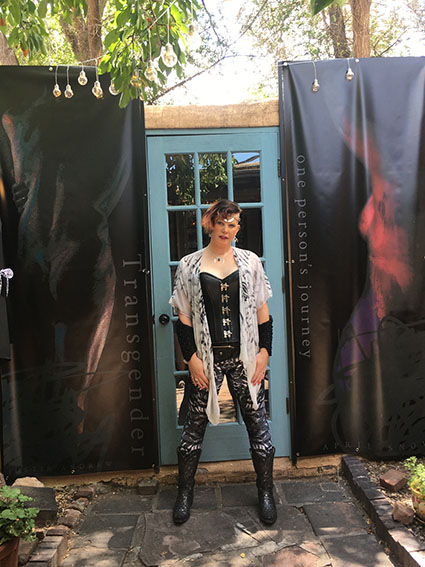Creative Image Sharpening With HDR Software
Unsharpened / Hybrid / Strong HDR
HDR software is most typically used to render shadow and highlight detail, but it can also be used to enhance tonal separation and detail in any range of tones, even in images with extremely low contrast. The very same tools that are used to compensate for HDR side effects can be used to sharpen any image.
When multiple bracketed exposures are merged into a single processed file, shadows and highlights that exceed the dynamic range of a camera’s sensor are compressed into the dynamic range of a digital file, taking the mid-tones with them. Depending on the HDR software used, a variety of tools are available to restore contrast and separation in mid-tones. If used aggressively, these tools produce the telltale signs of contemporary or grunge HDR artifacts – halos and texture accentuation. These are the very same artifacts that digital sharpening routines use more conservatively to make images appear sharper - only they look different.
Unlike the hard halo and line produced by the filter Unsharp Mask and more like the soft line produced by the filter High Pass, HDR sliders can give you still more points of control over line and texture, each with a slightly different flavor.
29 Great Quotes On Appreciation
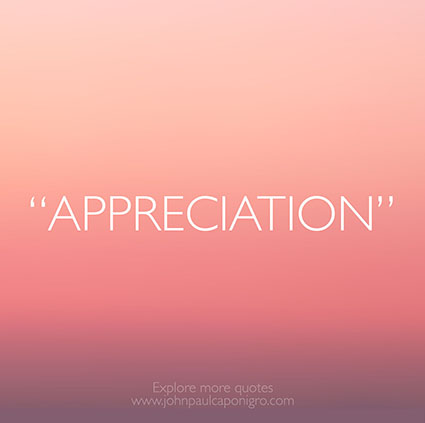
Enjoy this collection of quotes on Appreciation.
“Give thanks for a little and you will find a lot.” Hansa Proverb
“The roots of all goodness lie in the soil of appreciation for goodness.” – Dalai Lama
“By taking the time to stop and appreciate who you are and what you’ve achieved – and perhaps learned through a few mistakes, stumbles and losses – you actually can enhance everything about you. Self-acknowledgment and appreciation are what give you the insights and awareness to move forward toward higher goals and accomplishments.” – Jack Canfield
“Appreciation is a wonderful thing. It makes what is excellent in others belong to us as well.” ― Voltaire
“The difference between appreciation and flattery? That is simple. One is sincere and the other insincere. One comes from the heart out; the other from the teeth out. One is unselfish; the other selfish. One is universally admired; the other universally condemned.” ― Dale Carnegie
“The way to develop the best that is in a man is by appreciation and encouragement.” – Charles M. Schwab
“The invariable mark of wisdom is to see the miraculous in the common.” ― Ralph Waldo Emerson
“Nature’s beauty is a gift that cultivates appreciation and gratitude.” – Louie Schwartzberg
“Dwell on the beauty of life. Watch the stars, and see yourself running with them.” ― Marcus Aurelius
“I would rather be able to appreciate things I cannot have than to have things I am not able to appreciate.” ― Elbert Hubbard
“To get the full value of joy you must have someone to divide it with.” ― Mark Twain
“Knowing how things work is the basis for appreciation, and is thus a source of civilized delight.” – William Safire
“Indeed, I would feel that an appreciation of the arts in a conscious, disciplined way might help one to do science better.” – Subrahmanyan Chandrasekhar
“But perhaps the rest of us could have separate classes in science appreciation, the wonder of science, scientific ways of thinking, and the history of scientific ideas, rather than laboratory experience.” – Richard Dawkins
“The trouble with music appreciation in general is that people are taught to have too much respect for music they should be taught to love it instead.” – Igor Stravinsky
“Knowing what paint a painter uses or having an understanding of where he was in the history of where he came from doesn’t hurt your appreciation of the painting.” – Jodie Foster
“I learned more from my mother than from all the art historians and curators who have informed me about technical aspects of art history and art appreciation over the years.” – David Rockefeller
“Artworks are especially good at helping our psyches in a variety of ways: they rebalance our moods, lend us hope, usher in calm, stretch our sympathies, reignite our senses, and reawaken appreciation.” – Alain de Botton
“The essence of all beautiful art is gratitude.” – Friedrich Nietzche
“I’ve learned that universal acceptance and appreciation is just an unrealistic goal.” – Dan Brown
“As we express our gratitude, we must never forget that the highest appreciation is not to utter words, but to live by them.” – John F. Kennedy
“The more one does and sees and feels, the more one is able to do, and the more genuine may be one’s appreciation of fundamental things like home, and love, and understanding companionship.” – Amelia Earhart
“To be more childlike, you don’t have to give up being an adult. The fully integrated person is capable of being both an adult and a child simultaneously. Recapture the childlike feelings of wide-eyed excitement, spontaneous appreciation, cutting loose, and being full of awe and wonder at this magnificent universe.” – Wayne Dyer
“If you drive to, say, Shenandoah National Park, or the Great Smoky Mountains, you’ll get some appreciation for the scale and beauty of the outdoors. When you walk into it, then you see it in a completely different way. You discover it in a much slower, more majestic sort of way.” – Bill Bryson
“Workaholics typically have a lot of achievement with very little appreciation of what they have, whether it’s cars or friendships or otherwise. That is a shallow victory. Then you have people with a lot of appreciation and no achievement, which is fine, but it doesn’t create a lot of good in the world.” – Timothy Ferriss
“The two hardest tests on the spiritual road are the patience to wait for the right moment and the courage not to be disappointed with what we encounter.” ― Paulo Coelho
“The achievement is appreciation. Your ability to be surprised and awed by beauty!” – William Hurt
“I do not equate productivity to happiness. For most people, happiness in life is a massive amount of achievement plus a massive amount of appreciation. And you need both of those things.” – Timothy Ferriss
“Too much of a good thing can be wonderful!” ― Mae West
Explore The Essential Collection Of Creativity Quotes here.
View The Essential Collection Of Creativity Videos here
Discover more quotes in my social networks.
David DuChemin's New Mentor Class The Compelling Frame
David DuChemin recommends, “If you want sharper photographs, buy a new lens. If you want more compelling photographs, start here.” So do I. If you love David’s books (including Within The Frame and The Soul Of The Camera), like I do – his new online class The Compelling Frame is for you.
Haven’t been able to take one of his Mentor Series Workshops? The Compelling Frame is a great way to get started while you’re waiting.
“The Compelling Frame is a mentor class about making more compelling photographs by being more intentional about your compositions.” (David DuChemin) As with everything David does, it’s vision driven. There are no rules here. David deftly points out that the elements of composition and the forces they set in motion are nothing without purpose – and in your photographs that purpose is yours to choose. Put another way, without knowing what you want to do, you’re unlikely to know how to do it. David puts heart and soul into everything he does; that’s what makes him so great. And he encourages you to do the same because that’s what will make you great.
In the videos you spend less time watching David demonstrate and more time listening to him talk and ask you questions – about really important things. It’s like having a fireside chat with David; the fire is a monitor and the warmth you feel is David. The Compelling Frame is not just a series of videos to be watched passively, this is a class, and to get the most out of it you’ll want to do the exercises that accompany each lesson. It’s well thought out. This is the good work we all need to do. This includes looking carefully at other photographers images, looking carefully at your own, and making new ones. Do this work and you can’t help but make better photographs.
What do you get when you purchase The Compelling Frame? 19 Video Lessons, 31 Creative Exercises, 4 About The Image videos, 2 Craft & Creativity Videos, 2 eBooks, 3 Ask Me Anything Sessions, a one-year membership to Vision Driven a private Facebook community, and 10% off future MentorClasses.
The Compelling Frame is available for one week only – until Sep 20, 2017.
12 Great Photographs By David DuChemin


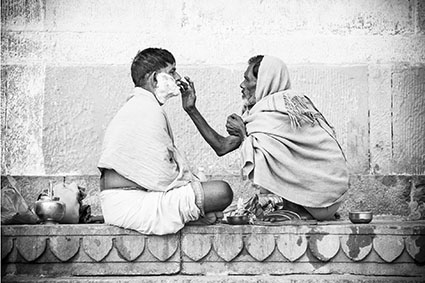
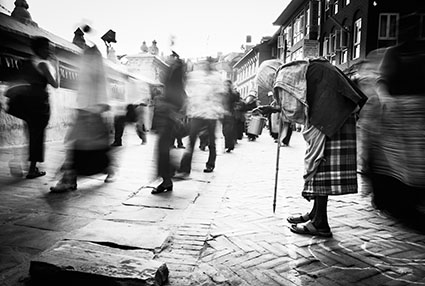


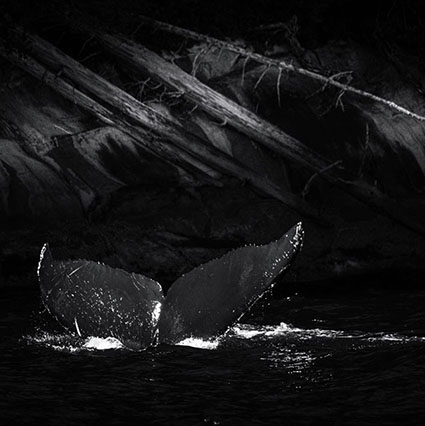
Enjoy this collection of photographs by David DuChemin.
Find out more about David DuChemin here.
Read David DuChemin’s Q&A here.
17 Great Quotes By Photographer David DuChemin
Enjoy this collection of quotes by photographer David DuChemin.
“The cliché comes not in what you shoot but in how you shoot it.” – David DuChemin
“Learning to see is not about having open eyes; it’s about having an open mind.” – David DuChemin
“The more curious we are the more creative we become.” – David DuChemin
“Creativity is about two things; the way we think, and the way we turn those thoughts into reality.” – David DuChemin
“It is we show put the humanity, the vision, and the poetry into our photographs.” – David DuChemin
“When we look at our photographs and find not the slightest reflection of ourselves, it is a good sign that our images have lost their souls.” – David DuChemin
“The idea of authenticity carries such value because we know how difficult it is to be fully ourselves.” – David DuChemin
“Anyone can take a picture of poverty; it’s easy to focus on the dirt and hurt of the poor. It’s much harder—and much more needful—to pry under that dirt and reveal the beauty and dignity of people that, but for their birth into a place and circumstance different from our own, are just like ourselves. I want my images to tell the story of those people and to move us beyond pity to justice and mercy.” – David DuChemin
“A representational photograph says, ‘This is what Vienna looked like.’ An interpretational photograph goes one better and says, ‘This is what Vienna was like. This is how I felt about it.” – David DuChemin
“‘What is it about?’ is not the same as ‘What happened?’” – David DuChemin
“It’s the difference between your wife’s passport photograph and the portraits you took when you got engaged. Both may have been created with similar technology, but what stands in that great gulf between them are the passion you have for your wife, the knowledge you have of her personality, and your willingness to use your craft, time, and energy to express that. One says, “She looks like this.” The other says, “This is who she is to me. It’s how I feel about her. See how amazing she is.” – David DuChemin
“Perfection is overrate, and not to be confused with mastery.” – David DuChemin
“Photographers, like few other kinds of artists I can imagine, have an insanely personal relationship with their gear.” – David DuChemin
“Knowing failure is part of our process, and leads to new ideas, stronger work, and more honest questions, liberates us to peer, a little less frightened, into the unknown.” – David DuChemin
“You yourself are unique–you have ways of seeing your world that are unlike those of anyone else–so find ways to more faithfully express that, and your style will emerge.” – David DuChemin
“The real failure is to rob this world of the contribution only you can make, and to fail to make work that truly gives you that ‘this is what I was created to do’ feeling that has no equal.” – David DuChemin
“I will never reach the end of this journey. I’ll never arrive at a point where others have nothing to teach me.” – David DuChemin
Find out more about David DuChemin here.
Read David DuChemin’s Q&A here.
Alumni Beal & Hartford Collaborate On Big Successes
This summer, two of John Paul Caponigro’s Next Step Alumni, Kathy Beal and April Hartford completed cornerstone projects in Santa Fe, and their success was enhanced by their support of each other.
–
The second week in June, Kathy Beal debuted her new active wear line, “Embodywear Fashions – Fit For Your Inner Goddess”, on the runways of Santa Fe Fashion Week. Her assistant for the event – April Hartford. Kathy reflected “it was getting close to show time, and I’d been so focused on getting the
Kathy reflected “it was getting close to show time, and I’d been so focused on getting the new product in and the website launched, that I neglected to look for an assistant to help me out during the three-day show. So I sent a last minute text to April, and she replied almost immediately – absolutely, I’ll be there! Really, I couldn’t have pulled it off without her help.” One benefit for April – she got to be one of the first to try on Kathy’s new fashions! Here
In mid-July, April Hartford was busy preparing for her opening “Transgender, One Person’s Journey” an exhibition of not only her incredible photographs portraying her journey, but some of the best educational materials available today for the transgender community. Shortly before her opening, she went to Kathy’s studio to put together a few outfits to wear during the exhibition and Embodywear Fashions quickly became a sponsor for April’s exhibit.
April shared, “Kathy has been instrumental in both feedback of my images and exhibition set up. One issue I face with such a personal story being laid out for all to see is a sense of protection. Wearing outfits designed by such a special friend helps ground me when at my studio. Though our work is so different, we come together through shared experiences and friends helping each other move past any obstacles or stumbling blocks in our paths.”
Magic really does happen when artist’s get together!
–
If you’re in Santa Fe, New Mexico …
Experience April’s exhibit thru October 7, 2017.
Transgender, One Person’s Journey
April Hartford Studio
539 Old Santa Fe Trail
Santa Fe, NM
Open for public viewing Tuesday’s, Friday’s, and Saturday’s from 1-6pm through October 7, 2017
April@aprilhartford.me
Tour the studio virtually here.
Learn more about April Hartford here.
–
Contact Kathy for a tour of her studio and an expert fitting for your own at Embodywear Fashions!
Kathy@kathybeal.com
Visit Embodywear Fashions by Kathy Beal.
The Weston Stories – Westons On Westons – 3 Videos
Kim Weston takes an historic trip down memory lane.
Edward Weston as remembered by his sons Brett, Cole, and Neil.
Brett and Cole Weston describe their work and legacy.
Explore 12 Great Photographs By Great Photographers
Explore The Essential Collection Of Quotes By Photographers.
Explore The Essential Collection Of Documentaries On Photographers.
Check Your Inboxes! My Newsletter Insights Is Out!

Check your inboxes!
My enews Insights is out.
This issue features many valuable resources on Color Theory.
Sign up here.
Remember, your username is your email. Your password is free.


